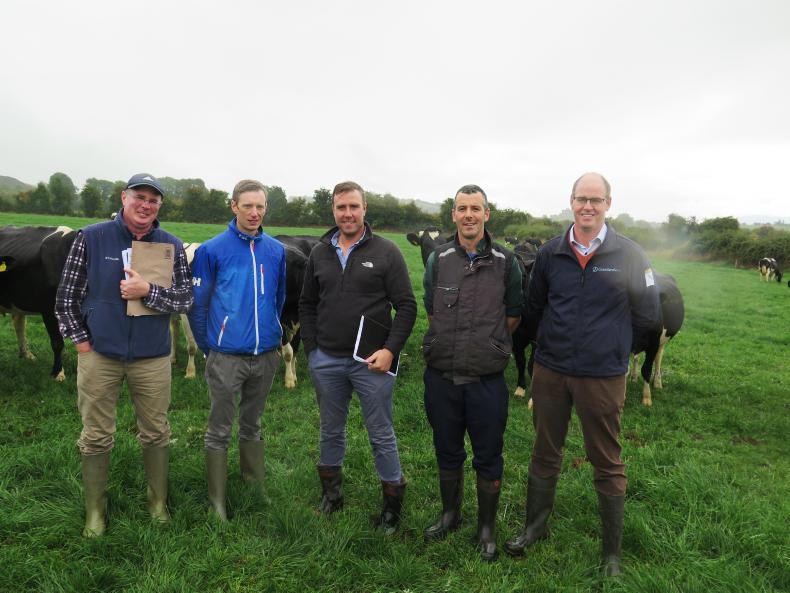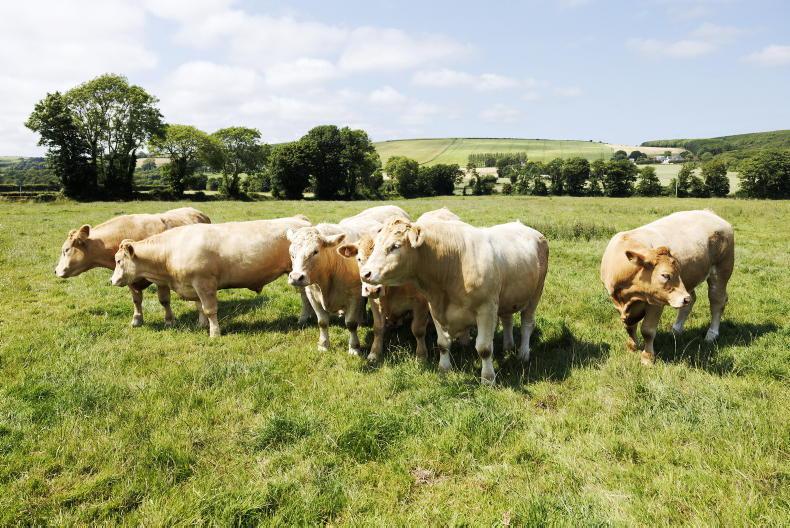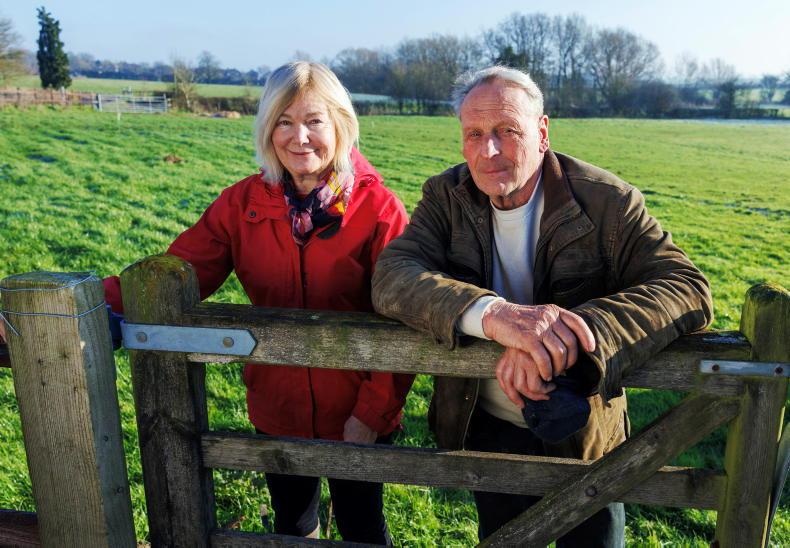Cashel
Co Tipperary
Michael Ryan has been involved in the family farm since he finished college in 2002, but as he says, it wasn’t until he took over the chequebook in 2009 that he was really in charge. The herd has expanded from 64 cows in 2009 to 140 cows today.
There are 40ha in the milking block so the stocking rate is high at 3.5 cows/ha. Michael says the stocking rate was four cows/ha last year, but extra land was leased so the stocking rate dropped. Long term, his plan is to stock the milking block at 3.7 to 3.8 cows/ha.
With such a high stocking rate on the milking block, getting good performance on the outfarms is key. Two outfarms are located between 4km and 9km away and these are used for heifers and silage.
Michael has measured growth of 15.2t/ha on the outfarms. The first grazing is at 1,300kg/ha. The next is a silage cut yielding 5.2t/ha. The second cut of silage yields 3.4t/ha, while the final cut is 2.9t/ha and the field is grazed again at a cover of 1,700kg/ha in November.
The milking block grew 16.7t/ha in 2017, up from 10.6t/ha in 2013. To achieve this, Michael has focused on soil fertility, reseeding and achieving a high number of grazings per year. The average number of grazings by Michael over the three years 2015 to 2017 was 8.9. Despite the fact that Michael is growing lots of grass, the soil fertility status of the overall farm is still poor enough, with one-third deficient in phosphorus and two thirds deficient in potash. Over 90% of the farm is on target for pH.
All slurry is spread on the outfarms by contractors and extra potash is spread in the form of muriate of potash every autumn to lift the indexes. Over the course of the year, Michael spreads 29 units of sulphur which he feels makes a huge difference to the farm.
Production per cow is excellent. Last year, the herd produced 550kg of milk solids and sold 515kg to the co-op. Michael fed about 750kg of meal per cow last year but will feed a lot more this year.
His farm is close to rock, being in the shadow of the Rock of Cashel. It is dry and free-draining facilitating early turnout. Extra roadways and spur roads were put in by Michael this year to make early spring grazing easier. The herd was scanned externally this year and just 7.2% of the cows were empty.

Judges Stan Lalor, Grassland Agro; Bryan Doocey, AIB; John Maher, Teagasc; Niall Moloney and Aidan Brennan, Irish Farmers Journal.
Crecora
Co Limerick
Niall is a contestant in the young farmer’s category. He qualified as a quantity surveyor in 2012 and was about to jump on a plane to find work overseas when they got to lease the farm next door. At the time, his father Gerry was milking 70 cows so there wasn’t enough for Niall to come home to, but when the other farm was leased it allowed them to milk 140 cows as the milking platform increased to 53.7ha.
“Even at 140 cows we couldn’t manage grass and were constantly taking out bales. We’re milking 163 cows now which is a stocking rate of 3 cows/ha and it works well,” Niall says.
Two outfarms provide silage and ground for rearing youngstock so it’s just cows at home. No reseeding was done on the home farm this year because of the drought. When the judges visited in early September, Niall was still celebrating the All-Ireland victory, but he was also still suffering from the drought. He had 1.2t of feed fed by then, up from 700kg fed over the full year in 2017. His aim is to feed 500kg/cow. Last year, the herd produced 437kg of milk solids per cow.
In terms of grass growth, the farm grew 13t/ha last year but Niall’s goal is to grow 15 to 17t/ha. He has joined a grass measuring discussion group and is focusing on improving soil fertility all the time. He soil-samples every year and applies extra P and K fertiliser based on the results. A new slurry tank with a trailing shoe spreader has just been purchased.
After doing the grass walk, the first thing Niall looks at is the pre-grazing yield. His target during the main grazing season is to be going into covers of 1,400kg. Paddocks above this are skipped over.
This is a real farm in development. Grazing infrastructure is good, with gaps and spur roads in place for early spring grazing. A new milking parlour was built three years ago.

John and Padraig McNamara with judges Bryan Doocey, AIB; Niall Ryan, Department of Agriculture; PJ O'Connor, Grassland Agro; John Maher, Teagasc and Gearoid
Hospital
Co Limerick
Farming with his wife Olive and young family who are all mad keen for farming, John McNamara’s farm at Gormanstown is an impressive place. Milking 240 cows on a 75ha milking block, John grew an average of 15.4t/ha over the last three years. Last year, the farm grew 16.8t/ha but the bad spring and drought took its toll this year and growth will be back a good bit. John got through the drought by zero-grazing grass back from the outfarm.
“We’re not a very early farm anyway. We normally only grow about 0.6 or 0.7t/ha in the spring whereas others might grow over 1t/ha. We’d usually make up for it during the summer though because when Moorepark starts to burn up we’d still be fine but this summer was different,” John says.
When the judges visited in late August, the farm was only just coming out of the drought and was growing 40kg/day. Unusually, the area got very little rain right through the summer.
John measures grass 41 times a year and soil-samples annually. The farm has expanded a lot in recent years with extra land purchased and leased. Some of the new land was drained so working on soil fertility has been a big priority for John. The McNamaras have a 38ha outfarm where they rear youngstock and grow silage.
Calving starts in late January and cows are turned out to grass straight away. John uses on/off grazing to get grass into cows and to achieve the target area grazed per day. The herd is a mix of New Zealand Friesian and Jersey crossbred cows. Last year John sold 466kg of milk solids per cow from 380kg of meal.
The infrastructure on this farm is excellent, with super roadways and access to paddocks. John uses a type of red shale from a local quarry. He says the stone needs to be weathered before going on a roadway, so where it comes from in the quarry is important.
He gets a track machine to lay a track in the stone and then spreads clean water from a vacuum tanker on the road before rolling with a big vibrating roller.
Cashel
Co Tipperary
Michael Ryan has been involved in the family farm since he finished college in 2002, but as he says, it wasn’t until he took over the chequebook in 2009 that he was really in charge. The herd has expanded from 64 cows in 2009 to 140 cows today.
There are 40ha in the milking block so the stocking rate is high at 3.5 cows/ha. Michael says the stocking rate was four cows/ha last year, but extra land was leased so the stocking rate dropped. Long term, his plan is to stock the milking block at 3.7 to 3.8 cows/ha.
With such a high stocking rate on the milking block, getting good performance on the outfarms is key. Two outfarms are located between 4km and 9km away and these are used for heifers and silage.
Michael has measured growth of 15.2t/ha on the outfarms. The first grazing is at 1,300kg/ha. The next is a silage cut yielding 5.2t/ha. The second cut of silage yields 3.4t/ha, while the final cut is 2.9t/ha and the field is grazed again at a cover of 1,700kg/ha in November.
The milking block grew 16.7t/ha in 2017, up from 10.6t/ha in 2013. To achieve this, Michael has focused on soil fertility, reseeding and achieving a high number of grazings per year. The average number of grazings by Michael over the three years 2015 to 2017 was 8.9. Despite the fact that Michael is growing lots of grass, the soil fertility status of the overall farm is still poor enough, with one-third deficient in phosphorus and two thirds deficient in potash. Over 90% of the farm is on target for pH.
All slurry is spread on the outfarms by contractors and extra potash is spread in the form of muriate of potash every autumn to lift the indexes. Over the course of the year, Michael spreads 29 units of sulphur which he feels makes a huge difference to the farm.
Production per cow is excellent. Last year, the herd produced 550kg of milk solids and sold 515kg to the co-op. Michael fed about 750kg of meal per cow last year but will feed a lot more this year.
His farm is close to rock, being in the shadow of the Rock of Cashel. It is dry and free-draining facilitating early turnout. Extra roadways and spur roads were put in by Michael this year to make early spring grazing easier. The herd was scanned externally this year and just 7.2% of the cows were empty.

Judges Stan Lalor, Grassland Agro; Bryan Doocey, AIB; John Maher, Teagasc; Niall Moloney and Aidan Brennan, Irish Farmers Journal.
Crecora
Co Limerick
Niall is a contestant in the young farmer’s category. He qualified as a quantity surveyor in 2012 and was about to jump on a plane to find work overseas when they got to lease the farm next door. At the time, his father Gerry was milking 70 cows so there wasn’t enough for Niall to come home to, but when the other farm was leased it allowed them to milk 140 cows as the milking platform increased to 53.7ha.
“Even at 140 cows we couldn’t manage grass and were constantly taking out bales. We’re milking 163 cows now which is a stocking rate of 3 cows/ha and it works well,” Niall says.
Two outfarms provide silage and ground for rearing youngstock so it’s just cows at home. No reseeding was done on the home farm this year because of the drought. When the judges visited in early September, Niall was still celebrating the All-Ireland victory, but he was also still suffering from the drought. He had 1.2t of feed fed by then, up from 700kg fed over the full year in 2017. His aim is to feed 500kg/cow. Last year, the herd produced 437kg of milk solids per cow.
In terms of grass growth, the farm grew 13t/ha last year but Niall’s goal is to grow 15 to 17t/ha. He has joined a grass measuring discussion group and is focusing on improving soil fertility all the time. He soil-samples every year and applies extra P and K fertiliser based on the results. A new slurry tank with a trailing shoe spreader has just been purchased.
After doing the grass walk, the first thing Niall looks at is the pre-grazing yield. His target during the main grazing season is to be going into covers of 1,400kg. Paddocks above this are skipped over.
This is a real farm in development. Grazing infrastructure is good, with gaps and spur roads in place for early spring grazing. A new milking parlour was built three years ago.

John and Padraig McNamara with judges Bryan Doocey, AIB; Niall Ryan, Department of Agriculture; PJ O'Connor, Grassland Agro; John Maher, Teagasc and Gearoid
Hospital
Co Limerick
Farming with his wife Olive and young family who are all mad keen for farming, John McNamara’s farm at Gormanstown is an impressive place. Milking 240 cows on a 75ha milking block, John grew an average of 15.4t/ha over the last three years. Last year, the farm grew 16.8t/ha but the bad spring and drought took its toll this year and growth will be back a good bit. John got through the drought by zero-grazing grass back from the outfarm.
“We’re not a very early farm anyway. We normally only grow about 0.6 or 0.7t/ha in the spring whereas others might grow over 1t/ha. We’d usually make up for it during the summer though because when Moorepark starts to burn up we’d still be fine but this summer was different,” John says.
When the judges visited in late August, the farm was only just coming out of the drought and was growing 40kg/day. Unusually, the area got very little rain right through the summer.
John measures grass 41 times a year and soil-samples annually. The farm has expanded a lot in recent years with extra land purchased and leased. Some of the new land was drained so working on soil fertility has been a big priority for John. The McNamaras have a 38ha outfarm where they rear youngstock and grow silage.
Calving starts in late January and cows are turned out to grass straight away. John uses on/off grazing to get grass into cows and to achieve the target area grazed per day. The herd is a mix of New Zealand Friesian and Jersey crossbred cows. Last year John sold 466kg of milk solids per cow from 380kg of meal.
The infrastructure on this farm is excellent, with super roadways and access to paddocks. John uses a type of red shale from a local quarry. He says the stone needs to be weathered before going on a roadway, so where it comes from in the quarry is important.
He gets a track machine to lay a track in the stone and then spreads clean water from a vacuum tanker on the road before rolling with a big vibrating roller.











SHARING OPTIONS